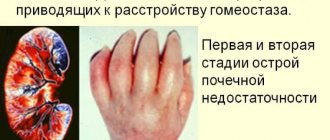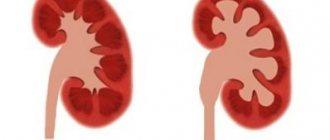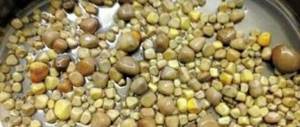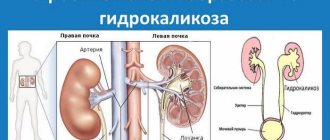CRF (chronic renal failure) is a severe pathology of the urinary system. With this disease, the kidneys partially or completely lose their functionality.
The disease develops at a slow pace and has several stages of development. Each stage is accompanied by certain changes in the functioning of paired organs and the entire organism as a whole. With timely diagnosis and proper treatment, the development of pathology can be stopped and thereby prevent its transition to more severe stages.
Pathogenesis and etiology of chronic renal failure
We can talk about the presence of chronic renal failure if the pathology is observed for at least three months. Today, out of a million people, 300–600 are diagnosed with this disease. Most often, the disease causes various pathologies of the organ. Often the main cause of renal failure is urological diseases.
Chronic renal failure develops over several stages. Gradually, the number of normally functioning nephrons decreases, which leads to a decrease in kidney performance. As a result, the normal functioning of the organ can be completely stopped. The pathogenetic mechanism of this disease is associated with this.
The rate of development of this pathology can vary significantly depending on the causes of the disease. The most rapid development of chronic renal failure is observed with amyloid, as well as diabetic nephropathy and mixed nephritis. And, say, with pyelonephritis, the pathology develops quite slowly.
Analyzes
The essence of the disease is a disorder in the functioning of the kidneys and failure to perform the main function - excretion. As a result of the change that has occurred, metabolic products that are not removed from the body by the system begin to accumulate in the blood. The disease can occur in acute or chronic form. Acute renal failure is characterized by a sharp and rapid failure of the kidneys. Long-term renal failure develops over a long period of time and does not provide success in treatment, while acute renal failure can be cured with timely consultation with a specialist.
To identify chronic renal failure in a patient, a number of tests are performed to reveal the presence or absence of features characteristic of the pathology:
- A general blood test to determine anemia: a decrease in the number of red blood cells and hemoglobin; an increased rate of precipitation of red blood cells and an increase in the number of leukocytes indicates the presence of an inflammatory process. The platelet count changes. Their number is decreasing.
- A biochemical blood test in chronic renal failure reveals elevated levels of urea, creatinine, potassium and phosphorus, and cholesterol. The level of calcium, blood protein, and blood clotting is decreasing.
- A urine test shows the appearance of protein and red blood cells in the urine; from this, one can judge the degree of kidney destruction.
- The Rehberg-Toreev analysis reveals the state of the kidney's excretory function. With its help, the glomerular filtration rate is determined, which normally ranges from 80-120 milliliters per minute.
The value of the glomerular filtration rate represents a reference indicator in determining the disease itself and the degree of its development; it characterizes the functional position of the renal system.
Classification of renal failure and creatinine level
When it comes to the classification of this disease, most experts take into account the work of Kuchinsky and Lopatkin, who described the four stages of pathology:
- Latent stage
- there is a decrease in the glomerular filtration rate to 60–50 milliliters per minute. All changes that occur at this stage in the body can be detected using laboratory tests. The stage of clinical manifestations - the decline in glomerular filtration rate continues and reaches a level of 49–30 milliliters per minute. Since tubular reabsorption is disrupted, the daily urine output increases to 2 or 2.5 liters. - Stage of decompensation
- the glomerular filtration rate is 29–15 milliliters per minute, tubular secretion worsens, and the level of creatinine in renal failure at this stage ranges from 0.2 to 0.5 mlmol/liter. - Terminal stage
- changes in the functioning of the kidneys become irreversible, and the organ cannot perform its job. The concentration of urea and creatinine increases sharply, and the balance of electrolytes is disturbed.
As a result, uremic intoxication develops, and urine ceases to be excreted.
In addition to the kidneys, pathological changes also affect other organs, for example, blood circulation may deteriorate or pulmonary edema may appear. In addition to all of the above, each of the above stages differs in the concentration of creatinine in renal failure:
- Stage No. 1 - creatinine level increases to 440 µmol/liter.
- Stage No. 2 - the level of the substance rises to 440–880 µmol/liter.
- Stage No. 3 - the creatinine concentration reaches 1320 µmol/liter.
- Stage No. 4 - the level of the substance exceeds 1320 µmol/liter.
Nitrogen slags
The main function of the kidneys is to remove all kinds of harmful components and toxins from the human body. This process must occur regularly. If the removal of such substances for some reason does not occur, then all organs are gradually poisoned and begin to perform their work worse.
- Residual nitrogen;
- Urea;
- Uric acid;
- Creatinine.
It is the latter substance that is most indicative in diagnosing chronic renal failure: knowing its quantity, one can accurately establish the diagnosis and its stage. Having identified the volume of other nitrogen slags, a specialist will not be able to determine the exact stage. But urea and residual nitrogen can clarify the diagnosis.
Of these biochemical compounds, the last one is most indicative for the diagnosis of chronic renal failure: based on the concentration of creatinine, one can confidently determine the stage of the disease. The levels of other nitrogenous wastes are ineffective and do not affect the determination of the stage of chronic renal failure. However, urea and residual nitrogen concentrations can help diagnose renal failure.
Symptoms of kidney failure and anemia
At the first stage of pathology development, there are quite few objective and subjective symptoms.
At the same time, thanks to a thorough questioning of the patient, the following symptoms can be identified: dry mouth, increased weakness at the end of the day, and high fatigue. At the stage of clinical manifestations, the symptoms of the disease become more distinct, and a decrease in appetite and neurological disorders may also be observed. At the third stage, the patient begins to complain about deteriorating health. This occurs simultaneously with exacerbation of chronic renal failure. In turn, after proper drug treatment, patients note an improvement in their condition.
All the symptoms described above at this stage of development of the pathology are persistent. Vomiting and an unpleasant taste in the mouth appear. The skin acquires a yellowish tint, its dryness and flabbiness are noticeable. Muscle tone decreases, and small muscle twitches begin to appear, as well as tremors of the hands and fingers. In addition, pain in joints and bones may occur. Any mild respiratory disease is very difficult for the patient to tolerate.
At the last stage of pathology development, death occurs in most cases. This can only be avoided through a kidney transplant, and with the help of lifelong hemodialysis, death can be delayed. The main symptoms of this stage are daytime drowsiness, lethargy, disturbed sleep, and memory problems. The patient's face becomes puffy and acquires a characteristic yellow-gray tint.
In addition, unhealthy thinness is very noticeable, and body temperature is most often reduced. Aphthous stomatitis begins to develop and when talking with the patient, you can feel an ammonia odor from the mouth. In addition, there is constant bloating, and diarrhea and vomiting are regular.
Simultaneously with the fourth stage of the disease, anemia also develops. This leads to an even more serious deterioration in the patient's health. The development of anemia is associated with a decrease in the level of erythropoietin, necessary for the synthesis of red blood cells. As you know, red blood cells contain hemoglobin, which is necessary for normal gas exchange.
Treatment of concomitant diseases
With a small amount of creatinine in the circulatory system in the initial stages of chronic renal failure, it is necessary to limit the consumption of protein foods. Recommended: protein of plant origin (soy), meat and fish products are not recommended. You also need to maintain normal calorie intake to maintain energy balance.
In later stages of chronic renal failure, it is necessary to significantly reduce the intake of proteins, phosphorus and potassium. To maintain a normal amount of amino acids, specialists prescribe medications. The following should be excluded from the diet:
- Mushrooms;
- Beans;
- Nuts;
- Bakery products made from wheat flour;
- Dairy products;
- Chocolate;
- Cocoa.
Detoxification
This is done by injecting solutions into a vein. This helps to bind and remove toxic components from the body that have accumulated in the blood vessels. Most often, sorbents or carbonates are used. If intravenous infusions are ineffective (according to the results of azotemia), replacement therapy is necessary.
Hemodialysis
An important indicator for dialysis is the high content of nitrogen compounds. If such serious illnesses as diabetes mellitus or hypertension are present, then dialysis cleaning is carried out already at stage 2. However, the main indicator of this method is stage 3.
After any procedure, laboratory tests are carried out to determine the following indicators:
- General blood and urine analysis;
- Content of creatinine and urea 1 hour after the procedure;
- Determination of the amount of calcium, phosphorus and sodium.
The improvement of the general condition is facilitated by the processes of removing nitrogen compounds, since an increased content of toxic substances can cause the development of the following ailments: low hemoglobin content in the blood serum, inflammation of the gastric mucosa of an erosive nature, diseases of the joints and skeletal system of the body, increased content of phosphate compounds with a high risk of developing urolithiasis diseases.
The main goals of treatment of concomitant diseases are:
- Pressure equalization;
- For diabetes mellitus - normalization of sugar in the circulatory system;
- Reduction of lipids in the blood;
- Preventive measures aimed at preventing the development of undesirable consequences;
- Normalization of water-electrolide balance.
It is also necessary to reduce the loss of protein in the urine to 0.3 g/day; for this purpose, drugs from the group of receptor inhibitors or blockers are prescribed. Statins and fibrates are used to reduce cholesterol levels. If the last stages of chronic renal failure are present, hemodialysis or kidney transplantation is performed.
Symptoms of chronic kidney disease
Diagnosis of chronic renal failure
As we said above, diagnosing the pathology at the first stage is quite difficult, since the disease is almost always asymptomatic. This disease can be diagnosed at the initial stage only through laboratory tests. Among the most informative analyzes it should be noted:
- Urine osmolarity.
- Creatinine in renal failure.
- An indicator of glomerular filtration rate.
In addition, some instrumental studies can give positive results in diagnosing the disease:
- Ultrasound of the entire urinary system with simultaneous determination of blood flow in the kidneys.
- Needle biopsy of the kidneys.
- X-ray of the organ.
In addition, to diagnose chronic renal failure, it is necessary to seek advice from a nephrologist, ophthalmologist and neurologist.
Nature of the disease
Experts identify quite a few different classifications of the disease. However, among doctors it is customary to use only two types: according to the level of decrease in glomerular filtration and according to the amount of creatinine in the blood.
For the first characteristic there are several stages:
- Hidden - glomerular filtration rate of 90 ml/min or more;
- Early - GFR from 60 to 89 ml/min;
- Moderate - in which the kidneys do only half their job, GFR ranges from 30 to 59 ml/min;
- Conservative. This classification is characterized by the filtration function of the kidneys being 20-50% of the required amount, GFR - 15-29 ml/min;
- Terminal stage of chronic kidney disease, when the kidneys practically stop working, GFR is less than 15 ml/min.
By the amount of creatinine:
- Reversible stage.
- Stable.
- Progressive.
How to treat chronic renal failure?
As you already understand, creatinine in renal failure, or rather the concentration of this substance, is one of the indicators of the presence of pathology.
Although there is now a fairly large list of medications that are used to treat this disease, there is no universal therapy. When prescribing medications, a doctor should be based on the test results of each individual patient and the situation as a whole. If we talk about drugs that show good results, then first of all these are minnit, epovitan, and also furosemide.
Antibiotics (carbenicillin or ampicillin) and aminoglycoside antibiotics are also often used.
Treatment with traditional methods
Chronic renal failure drags on for a long period of time; in addition to medications, traditional methods of therapy are acceptable. Patients use infusions and medicinal herbs for therapy. Variations of effective recipes:
- Mix birch leaves, astragalus grass, corn silk, flax seed, linden flowers, mint, burdock root, sage and blueberry leaves in identical proportions. Grind the resulting mixture, pour 2 tablespoons of the resulting mixture with five hundred milliliters of boiling water in a thermos. Let it sit overnight, drink a third of the infusion daily, 3 times a day.
- All ingredients are mixed in the same proportions - lingonberry leaves, viburnum and buckthorn bark, St. John's wort, motherwort, string, chamomile and meadowsweet flowers. The preparation of the solution and method of application are similar to the previous case.
- In equal proportions, combine lingonberry leaves, corn silk, meadowsweet grass, string and tricolor violets, flax seed, dandelion root, linden flowers, motherwort and blueberry shoots. The preparation of the infusion and the course of application correspond to the previously described methods.
Together with medicinal herbs and other plant components, similar preventive methods are used. An excellent remedy for kidney failure is pomegranate juice, which contains many trace elements and beneficial substances that balance the functioning of internal organs. It is better to use pomegranate juice that you have squeezed yourself. Such treatment is carried out after consulting a doctor and his approval or prohibition, because a certain substance can provoke individual changes in the body.
How to eat properly if you have kidney failure?
In case of chronic renal failure, you should adhere to a low-protein nutrition program.
It is very important to reduce the consumption of animal protein compounds to a minimum, and strictly dose those of plant origin. The main emphasis in the nutrition program for chronic renal failure should be on fats and carbohydrates. This will significantly alleviate the patient’s condition. It should also be noted that the nutrition program described above can slow down the development of pathology in some diseases, for example, diabetic nephropathy. When choosing a dietary nutrition program, you must consider the following points:
- Rate and stage of development of pathology.
- An indicator of the functional reserve of the kidneys.
- The amount of protein compounds that are excreted from the body in the urine.
- Indicators of water-electrolyte, as well as phosphorus-calcium metabolism.
- An indicator of energy expenditure, as well as the rate of protein catabolism.
At the moment, three nutrition programs have been developed for people suffering from this type of pathology.
They are selected depending on the creatinine concentration in renal failure, as well as the glomerular filtration rate. Here are some guidelines for organizing a nutrition program for kidney failure:
- It is recommended to consume from 40 to 60 grams of protein compounds throughout the day.
- Elimination of salt from the diet or maximum restriction on this product.
- The necessary indicator of the energy value of the diet should be provided through the consumption of fatty species of sea fish, complex carbohydrates, vegetable oils and fatty dairy products.
- Eliminate refractory animal fats from the diet.
- Instead of refined sugar, eat fruits, and replace white flour with “black” cereals.
- With the help of fruits and vegetables, it is necessary to ensure that the body receives all micronutrients.
- Drink at least 0.8–1 liters of water throughout the day.
The products must be boiled, and the broth must be drained.
We recommend eating small portions of food at least 5 times a day. Thus, the treatment of high creatinine levels in renal failure consists of treating the disease that provokes this pathology. All about creatinine in the following video:
Azotemia
When treating chronic renal failure, the doctor will dynamically determine the level of azotemia, a significant increase in which occurs when the condition worsens or in the absence of effect from treatment measures. Blood creatinine concentration is the most specific finding, but it is advisable to consider urea and uric acid levels. Sometimes determining the cause of the disease depends on this.
If blood urea levels are high and creatinine values are normal, the doctor will look for conditions that are not associated with renal pathology:
- excessive consumption of protein foods;
- severe malnutrition and hunger;
- severe loss of fluid from the body;
- excess metabolic processes.
If all nitrogen-containing compounds increase simultaneously, then we can confidently speak of chronic renal failure.
When dealing with chronic renal failure, a specialist will identify the amount of azotemia. This indicator increases when the patient's condition worsens or treatment does not bring the desired effect. Creatinine level is the most indicative parameter, but it is important to take into account the indicators of other nitrogen-containing wastes. Often this decision allows the doctor to establish the root cause of the disease.
If diagnostic tests reveal a high level of urea and a normal amount of creatinine, then the doctor will need to find a problem that is not related to kidney disease:
- High protein intake;
- Clear lack of food;
- Lack of fluid;
- Increased metabolism.
If the indicators of all nitrogen slags increase simultaneously, this indicates the presence of chronic renal failure.
Prevention
To ensure that creatinine does not go beyond normal limits, you need to maintain normal water metabolism in the body and to do this, consume the amount of fluid that the kidneys can handle. In addition, you need to not physically overstrain the body, sleep regularly and enough, and not disrupt your diet.
Elevated creatinine levels can lead to serious problems with the kidneys and other organs of the body. You need to do everything possible to ensure that its content remains normal, and to do this, follow a number of, in general, simple preventive measures.
Source: https://onwomen.ru/povyshennyj-kreatinin-v-krovi.html











